
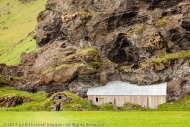
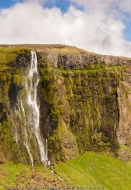
On my recent trip to Yellowstone National Park, I made no secret of the fact that I was looking for wolves. OK, I was looking for any wildlife I could find, as well as nice landscapes, but my primary objective was to see the wolves. And see them I did. Kind of.
Now at Yellowstone, one does not simply go find a wolf and start snapping photos. You might easily do that with the bison, the bighorn sheep, and the elk, but not the wolves. It seems that wolves are afraid of people for some reason, possibly because hunters, trappers, and even misguided park rangers completely wiped them out of the park by 1926. In fact, by the mid 1900s, there were almost no wolf packs left in the entire lower 48 states.
Around the 1960s, many became aware that man’s efforts to “manage” nature were doing much more harm than good, and one result of that was the passage of the Endangered Species Act in 1973. By 1978, wolves were on the list, and as the US Fish and Wildlife Service is required to try to restore endangered animals where possible, discussions about returning wolves to Yellowstone slowly began to take place. In 1987 the Northern Rocky Mountain Wolf Recovery Plan was proposed, and in 1991 Congress provided funds to prepare an environmental impact statement on restoration of wolves to the area. In 1994, after much heated public debate, the Secretary of the Interior signed the paperwork that would put the reintroduction into motion. In January of 1995, after some last minute dirty tricks by ranchers in the area put the lives of captured Canadian wolves in jeopardy, gray wolves were finally restored to their rightful home in the park.
So my point is, well, one of my points, is that wolves avoid people, and are thus difficult to photograph in the wild. But I was determined to get some images of these majestic creatures in their natural habitat, so simply going to a zoo was not going to do. I had to find wolves in Yellowstone.
Because the wolf reintroduction was such a controversial topic, primarily because of the ranchers’ opposition, much care has been taken over the last 20 years to monitor the behavior and movements of the wolves to try to mitigate any negative impact on the local human residents and their pets and livestock. As a result, one or two members of each pack, ideally, is fitted with a radio collar for monitoring, and members of the wolf recovery team to this day go out and track the movements of the wolves to the best of their ability.
OK, you want to know how the wolves are collared, don’t you. Well, it typically involves a helicopter, a dart gun, and some very interesting high speed chases in the snow. You can read more about that in the references at the end of this article.
Anyway, rangers routinely go out along the north road in the Lamar Valley where wolves congregate in the winter and search for the various packs using a radio receiver and a directional hand-held antenna. {Simply looking across the vast landscape, even with binoculars, is not going to work. They are simply too far away.) When they find a pack, a crowd is sure to follow. The tourist vans immediately show up and set up their high-powered spotting scopes, and pretty soon the turnout is packed with tourists and photographers. So the good news is that it’s actually pretty easy to find the wolves, and you don’t even need to pay a bundle for a guide as long as you have your own optics. The bad news is that the wolves are very far away. We’re talking miles here.
So let’s look at the type of landscape we have in the area. This is a pretty typical view of the Lamar Valley, taken from the road.
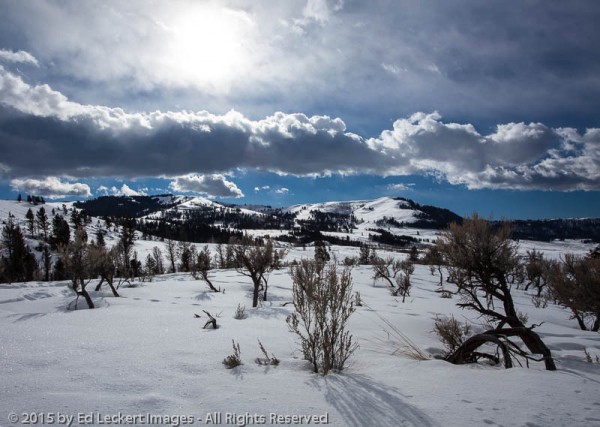
The afternoon sun peeks through clouds on a typical winter day, in Yellowstone National Park, Wyoming.
The wolves are usually going to stay close to those hills on the other side, near one of the small creeks that fill the valley. This is during the daytime – at nighttime they gather their belongings and head into the woods somewhere.
So are there any wolves in this photograph? Who knows? They are so small you would never be able to pick them out.
Well, what do you need to see them and photograph them? I’ve already mentioned the spotting scopes that the tour agencies use to allow their clients see the wolves. They are very high powered, and excellent for viewing the animals, but the image quality falls off on the edges of the image so abruptly that they are not much use for photography. No, for photography you need the big guns, and even then it’s difficult to tell a wolf from a rock when the beast is lying down in the snow.
In my case I use a Canon 600mm Super Telephoto lens, weighing in at over 8 1/2 pounds (3.9 kg) plus the camera body and tripod and costing, well, let’s not worry about that. But since I couldn’t actually see the wolves with just this, I even added a 1.4 extender, giving an equivalent 840mm and thus exceeding the magnification of the biggest lens Canon (typically) makes. So, I should be able to see something now, right? Well, take a look at what this gives me with a pack of wolves at an estimated distance of 2750 meters, or 1.7 miles across the valley.
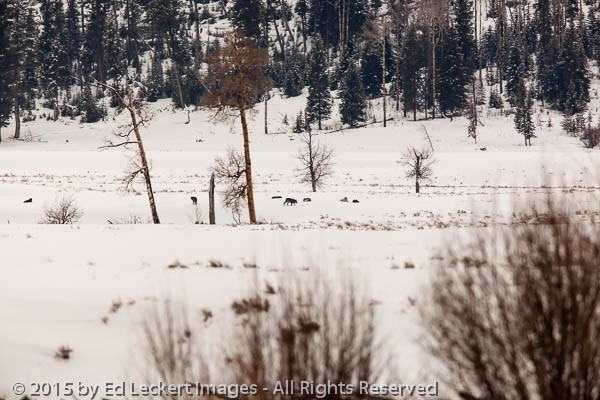
A wolf pack lounges in the snow, in Yellowstone National Park, Wyoming.
So how many wolves do you see? No idea, right? And it’s not a very compelling image, is it? Well, can I crop it? How sharp is the image, and what happens if I crop out everything but the wolves?
That’s a little better. You can actually tell that there are seven wolves hanging out, though a couple of them still almost look like rocks.
Well, can we go further? What happens if we crop a bit more to zoom in on the group on the right?
At least at this point you can really tell they are wolves and see what they are doing – essentially, a whole lot of nothing.Of course they don’t always do nothing, and they don’t always stay miles from the road. Wolves are carnivores, and they have to eat. One afternoon some very lucky visitors got to witness a very unlucky elk calf get taken down by a pack just about 100 yards (meters) off the highway. By the time I heard about it and visited the site the next morning, the wolves were long gone, but crows had moved in to feast on the carcass.
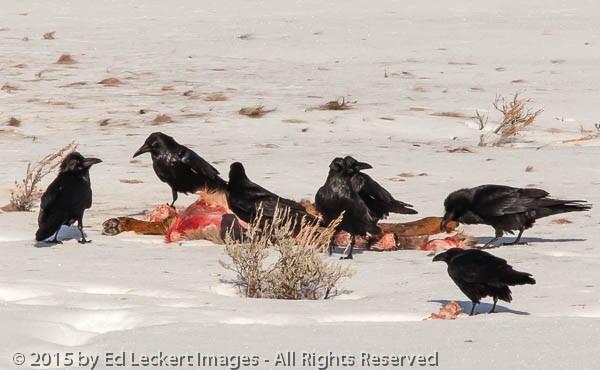
Crows feast on an elk calf taken down the previous evening by wolves, in Yellowstone National Park, Wyoming.
So how is the wolf reintroduction going after 20 years? I’m sure the ranchers are still pissed, but for the most part it has been an amazing success. You can read all about this fascinating story in the references below, but suffice it to say that parts of the ecosystem that have been out of whack for the last hundred years are finally coming into balance again, now that this unnatural removal of a vital component has been corrected. In fact, just researching the story of the wolves prior to my trip was one of the unexpected highlights of my adventure. Once you take the time to learn about these wonderful animals and their unique individual personalities, not only are they not scary, they’re almost human, and you can’t help but want to know more about their lives. Yes, they are that interesting!
So am I disappointed that I didn’t get closer to the wolves? Yes and no. It was still a great experience, and now I know a lot more about what I would need to do to get better shots. So I can go back and try again with some different strategies – or just go back a heck of a lot and hope I get lucky!
References:
The Wolves of Yellowstone
By Phillips, Michael K., 1958-
1996Decade of the Wolf
Returning the Wild to Yellowstone
By Smith, Douglas W., 1960-
2005Lost in My Own Backyard
A Walk in Yellowstone National Park
By Cahill, Tim
2004Mind of the Raven
Investigations and Adventures With Wolf-birds
By Heinrich, Bernd, 1940-
1999

Loved the post! The photo was great as well as the story behind it. Very interesting.
Ed, nice article. I really appreciated it. Great backstory on the Wolves and the reintroduction campaign. Nice insights on the lengths you jump through to get your shots. Thanks!